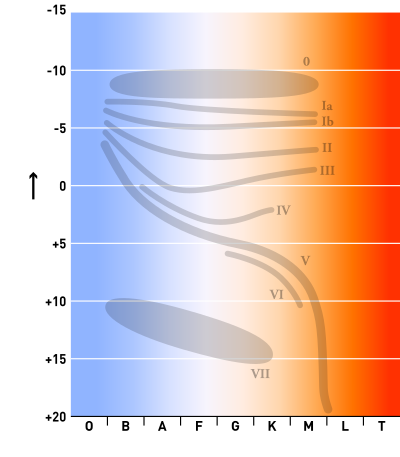
Back نجم أزرق فائق العملقة Arabic Superxigante azul AST নীল অতিদানব তারা Bengali/Bangla Supergegant blau Catalan Modrý veleobr Czech Сенкер вышкайсăр гигант CV Blua supergiganto Esperanto Supergigante azul Spanish Supererraldoi urdin Basque ابرغول آبی Persian
This article needs additional citations for verification. (November 2023) |
A blue supergiant (BSG) is a hot, luminous star, often referred to as an OB supergiant. They are usually considered to be those with luminosity class I and spectral class B9 or earlier,[1] although sometimes A-class supergiants are also deemed blue supergiants.[2][3]
Blue supergiants are found towards the top left of the Hertzsprung–Russell diagram, above and to the right of the main sequence. They are larger than the Sun but smaller than a red supergiant, with surface temperatures of 10,000–50,000 K and luminosities from about 10,000 to a million times that of the Sun. They are most often an evolutionary phase between high-mass, hydrogen-fusing main-sequence stars and helium-fusing red supergiants, although new research suggests they could be the result of stellar mergers.[4][5]
The majority of supergiants are also blue (B-type) supergiants; blue supergiants from classes O9.5 to B2 are even more common than their main sequence counterparts.[6] More post-main-sequence blue supergiants are observed than what is expected from theoretical models, which expect blue supergiants to be short-lived. This results in the blue supergiant problem, although unusual stellar interiors (such as hotter blue supergiants having oversized hydrogen-fusing cores and cooler ones having undersized helium-fusing cores) may explain this.[7]
- ^ Massey, P.; Puls, J.; Pauldrach, A. W. A.; Bresolin, F.; Kudritzki, R. P.; Simon, T. (2005). "The Physical Properties and Effective Temperature Scale of O-Type Stars as a Function of Metallicity. II. Analysis of 20 More Magellanic Cloud Stars and Results from the Complete Sample". The Astrophysical Journal. 627 (1): 477–519. arXiv:astro-ph/0503464. Bibcode:2005ApJ...627..477M. doi:10.1086/430417. S2CID 18172086.
- ^ Yüce, Kutluay (2005-01-01). "Spectral Analysis of 4 Lacertae and ν Cephei". Baltic Astronomy. 14: 51–82. Bibcode:2005BaltA..14...51Y. ISSN 1021-6766.
- ^ Burgos, A. de; Simon-Díaz, S.; Lennon, D. J.; Dorda, R.; Negueruela, I.; Urbaneja, M. A.; Patrick, L. R.; Herrero, A. (2020-11-01). "High-resolution spectroscopic study of massive blue and red supergiants in Perseus OB1 - I. Definition of the sample, membership, and kinematics". Astronomy & Astrophysics. 643: A116. arXiv:2008.13299. Bibcode:2020A&A...643A.116D. doi:10.1051/0004-6361/202039019. ISSN 0004-6361.
- ^ Menon, Athira; Ercolino, Andrea; Urbaneja, Miguel A.; Lennon, Daniel J.; Herrero, Artemio; Hirai, Ryosuke; Langer, Norbert; Schootemeijer, Abel; Chatzopoulos, Emmanouil; Frank, Juhan; Shiber, Sagiv (March 2024). "Evidence for Evolved Stellar Binary Mergers in Observed B-type Blue Supergiants". The Astrophysical Journal Letters. 963 (2): L42. Bibcode:2024ApJ...963L..42M. doi:10.3847/2041-8213/ad2074. ISSN 2041-8205.
- ^ Cite error: The named reference
:1was invoked but never defined (see the help page). - ^ Sowell, J. R.; Trippe, M.; Caballero-Nieves, S. M.; Houk, N. (2007-07-18). "H-R Diagrams Based on the HD Stars in the Michigan Spectral Catalogue and the Hipparcos Catalog". The Astronomical Journal. 134 (3): 1089. Bibcode:2007AJ....134.1089S. doi:10.1086/520060. ISSN 1538-3881.
- ^ Bellinger, Earl Patrick; de Mink, Selma E.; van Rossem, Walter E.; Justham, Stephen (2023-10-31). "The Potential of Asteroseismology to Resolve the Blue Supergiant Problem". arXiv:2311.00038 [astro-ph.SR].
